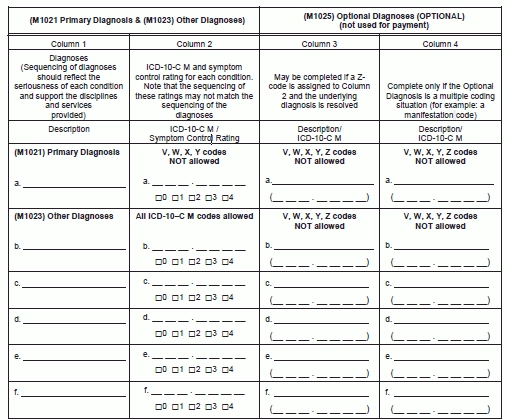Know What OASIS-C1 has in Store for Diagnosis Coding
While changes are obvious, your diagnosis OASIS items are still recognizable.
As ICD-9 makes way for ICD-10, so will OASIS-C move aside to let OASIS-C1 take over. Make sure you know your way around the new M items before October 1st arrives.
The biggest reason for the transition to OASIS-C1 is to accommodate seven character ICD-10 codes, said Judy Adams, RN, BSN, HCS-D, HCS-O, with Adams Home Care Consulting in Asheville, N.C.
But the Centers for Medicare& Medicaid Services took the opportunity to make some additional revisions to the OASIS form. These changes include updating clinical concepts and modifying item wording and response categories to improve item clarity, Adams said in the Eli-sponsored audioconference OASIS-C1 Changes.
Watch for: Wording changes in 44 OASIS items aim to make the language clearer. Expect more straightforward directions and response options and more specific data collection periods. You can also say goodbye to confusing abbreviations as “for example” replaces “e.g.” and “specifically” takes the place of “i.e.” throughout the OASIS.
OASIS-C1 Diagnoses Items
Welcome New Diagnosis Coding Items
As promised, the diagnosis coding items have all undergone changes. So much so, that the items will be renumbered in OASIS-C1.
New items M1011, M1017, and M1025 all forbid the use of V, W, X, Y, and Z codes, while V, W, X, and Y codes are off limits for item M1021. In ICD-10, V, W, X, and Y codes report external causes of injuries and other adverse effects — similar to ICD-9’s E codes. Z codes, like V codes in ICD-9, are used in ICD-10 to report the reason for an encounter. Z codes may be coded as primary or in the secondary items (M1023).
Understand Optional Diagnoses Item M1025
Changes to M1024 — Payment Diagnoses had many home health experts assuming this item was on its way out. But in OASIS-C1 it morphs into M1025 rather than disappearing entirely. CMS kept M1025 in the OASIS because agencies expressed concern about the item going away, Adams said. Agencies wanted a place to show a diagnosis that isn’t current, such as a resolved diagnosis, but that impacts why the agency is providing care, Adams said.
OASIS item M1024 had been used to list diagnoses that could have a payment impact when they replaced by V codes in M1020 or M1022. But as of January 1, 2013 CMS limited use of M1024 to fracture codes only, in situations where the agency is providing aftercare for a healing fracture.
As we transition to ICD-10, there will no longer be a need for an item to gather fracture codes replaced by V codes, Adams said. That’s because reporting care for fractures in the new coding system is an entirely different process. Rather than reporting a separate aftercare code, you’ll list the code for the fracture itself with a seventh digit that indicates subsequent encounter. “So the whole issue of having a V code replace the code will go away,” she said.
The directions for Column 3 of M1025 advise:
“There is no requirement that HHAs enter a diagnosis code in M1025 (Columns 3 and 4). Diagnoses reported in M1025 will not impact payment but may be used to risk adjust quality measures Agencies may choose to report an underlying condition in M1025 (Columns 3 and 4) when:
a Z-code is reported in Column 2 AND the underlying condition for the Z-code in Column 2 is a resolved condition. An example of a resolved condition is uterine cancer that is no longer being treated following a hysterectomy.”
Column 4 of M1025 is also optional. CMS instructs:
“If a Z-code is reported in M1021/M1023 (Column 2) and the agency chooses to report a resolved underlying condition that requires multiple diagnosis codes under ICD-10-CM coding guidelines, enter the diagnosis descriptions and the ICD-10-CM codes in the same row in Columns 3 and 4. For example, if the resolved condition is a manifestation code, record the diagnosis description and ICD-10-CM code for the underlying condition in Column 3 of that row and the diagnosis description and ICD-10-C M code for the manifestation in Column 4 of that row. Otherwise, leave Column 4 blank in that row.”
The current OASIS algorithm doesn’t look at M1024 very frequently, Adams said. “M1025 is an optional item. Your agency can choose to fill it in if you wish, but there is no advantage to payment.”
Note: To order a CD or transcript of Adams’ audioconference, visit www.audioeducator.com/home-health/oasis-c-1-2014-01-22-14.html.

